Where to add the name
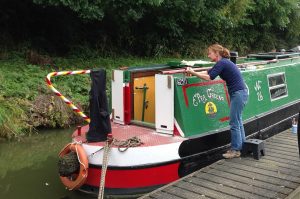
With the outside of Pea Green’s cabin painted green, and the name officially changed on the Canal and River Trust (CRT) website all that remained was to paint the new name on the boat. This of course, had to be done twice, on each side. With my usual approach of not doing things in half measures I decided to add a picture, and the number 26, and paint boxes around it all. This would, of course, been fine if I had any training or skill in signwriting, however my previous ‘signwriting’ experience was limited to daubing my house number on the wheelie bin. Nothing quite like setting yourself a challenge… I decided that to save face I wouldn’t be trying the signwriting in the marina. If it all went pear shaped I wanted to be able to paint it out fast, so no one would see the error of my ways.
A gentle meander
At the end of July 2017 I headed out of the marina for a three week saunter, Monte the Cat had gone on holiday to Skegness (no, really he had), so, I didn’t need to worry about him. At that point in time I was still learning to handle the boat and didn’t feel secure having the ginger one meandering around the single open cabin. It was also the first time I had taken the boat out for any longer than a week. I rarely get very far, as I don’t like long days of cruising. My limit is a few hours at a stretch, and as a female single-hander you pretty much always have to moor up to use the loo (I am not into hanging my bum off the back of the boat). I realise others have a different outlook- to long days of cruising that is, rather than bums off the back of their boat. Last year I met a couple, on holiday, who were cruising for 10 hours daily. On one day alone they had gone through 21 locks – the girlfriend of the boat owner didn’t look like she would be around for much longer, and in all honesty I didn’t blame her. She had been working the locks and in the process had found muscles she had been previously unaware of.
Otter!
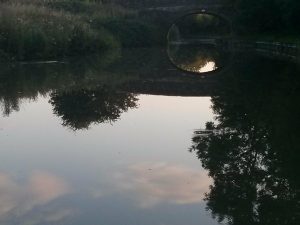
Anyway, my 3 week waft seemed like a good time to get the name on the boat. I spent my first night not far from Welford at Bridge 36, where I was excited to see my first UK otter. I was sitting in the cratch looking down the canal and could see a long rippling V moving towards me in the water. Having ruled out the possibility of a shark (I am a scuba diver, though not in canals) it took me a while to realise it was an otter moving swiftly down the canal. In the summer twilight and stillness it was a magical sight. The next day, fired up by seeing the otter, I made it through all of 12 bridges to Bridge 24. This is one of my favourite spots on the Leicester Line of the Grand Union, not least because there are mooring rings, a bench and a wider bit of tow path.
Starting to paint
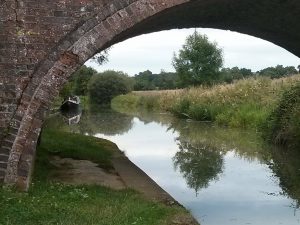
The weather was also good so I set up my folding stool and began looking at the side of the boat to try and work out how to get the name on. I began with measuring, but there were two complications. Firstly, I have never been very good at measuring things – nor drawing straight lines for that matter. Secondly the windows on my boat are laid out differently on both sides. On the starboard they start with a porthole, followed by two rectangular windows, whereas on port they start with a rectangular window, then a porthole, then another window. As a result, starboard has more space for sign-writing. I decided that I had better measure equal spaces for the name on both sides, otherwise it would be very noticeable that I had messed up. With the rectangles measured, I began on the towpath side drawing two parallel arcs for the script in chinagraph pencil. Next came the tricky bit of writing ‘Pea Green’ ready to paint.
Choosing a font
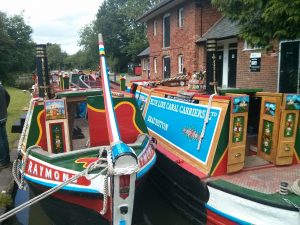
Originally I had planned to write Pea Green in a cursive script using capitals and lower case letters. However, as my chinagraph pencil stumbled and snagged on the wibbly-wobbly GRP cabin it became obvious that I would never get the three lower case Es similar, let alone identical. So, with a beer in hand I ditched the cursive idea and went for capital letters all the way, at least then I would be getting rid of lots of curves on the letters, and I could measure the bits of the E. Now I understood why the old working boats were usually done in block capitals – far easier to measure and get right.
History of signwriting on narrowboats
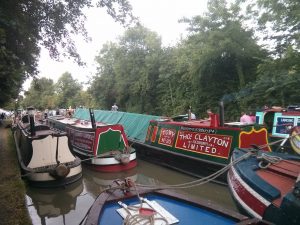
The history of signwriting on narrowboats goes back to the days of the working boats. Different companies had their own livery colours, which shifted and developed over the years. These designs along the back cabin had to contain a lot of information relating to the name of the owner or the carrying company, and the place of registration. More explanation can be found on the Inland Waterways Website and the website Canal Junction . Often, they were not painted by a professional, but rather by someone who was handy with a paintbrush in the boatshed, so I felt in good company with my amateurish attempt! The working boats that are still around today are often loving restored and have recreated the original colours and signwriting. It is always a pleasure to see the old boats and the different styles of signwriting. Today, apart from the boat licence number CRT do not enforce the boat name being painted on the side of the boat, however all boats do have to have a name.
Don’t paint and drink!
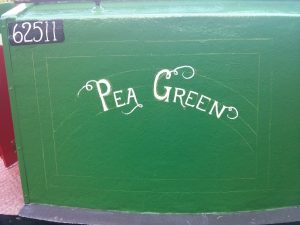
Back to Pea Green. As the afternoon progressed I began to realise that signwriting on the cut was probably not the best. Every time a boat passed I had to stop painting as my boat moved. Adding in beer also didn’t make for a totally steady hand! Despite these impediments, and not being prepared to ditch the beer, I did manage to get the name drawn and painted. I am sure a signwriter would look at my first attempt and be able to immediately identify where I had gone wrong (putting aside not using coach-enamel paints). It took me a bit longer to work out that the name was not even or balanced on the curve, so that night I went to bed and slept on it, deciding what to do to sort it out.
Transferring the name
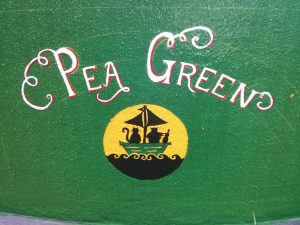
In the cold light of day (literally colder and with no beer) I decided I would add some swirly embellishments to try and add some balance. A couple of people have pointed out how these look like pea tendrils, so I feel perfectly vindicated with my additions. I also added red shading to the white letters. Again, I didn’t get this right straight away, and did have to paint bits out and re-do. Finally I drew in my picture and began painting the silhouette of the owl and the pussy cat in their pea green boat. By the end of day two I had almost completed the first side and although not the fabulous work of the professionals I was quite pleased with the result, and it seemed right for my far from perfect little, old boat.
Heading to Norton
With one side of my boat painted I now had to move on to a place where the towpath was on the other side of Pea Green. I could then attempt adding the name to the port. I didn’t move before I had traced the name onto grease proof paper ready to transfer. Once the tracing was made I headed to the Watford flight, and onto Norton Junction where I knew I the towpath would be on the correct side. Norton also had the added attraction of a pub, handy for gin and tonic, which I don’t have on the boat, as I can’t work out a way to keep ice onboard!
Towpath chat
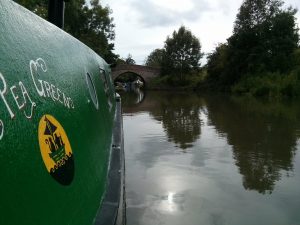
With the boat moored up I used my grease proof paper tracing to transfer the name. It was so much less stressful transferring the name, rather than starting from scratch, plus the old childhood method of tracing worked quite well. With the name on the side I began to paint. This was a different experience as Norton Junction has a steady stream of boats passing and people walking the towpath, a number came to chat as I daubed on the paint. It all went well and after an evening at the pub where I met a lovely couple who had just picked up their boat from Whilton Marina. Next day I headed off towards Braunston.
Braunston boat
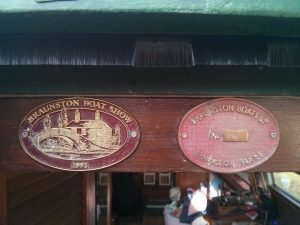
I swear my boat begins to dance in the water as she comes out of the bottom lock at Braunston – either that or I do need to cut down on the gin… Braunston is where Pea Green was built back in 1973, and it always makes me smile when she is recognised there as a Barney boat. This doesn’t just happen in Braunston, and I have had long towpath conversations with Barney boat experts who tell me the ins and outs of where the surviving Barney’s are moored. This recognition of my boat is what led me to add the final bit of my signwriting – No 26.
Incognito licence number collector
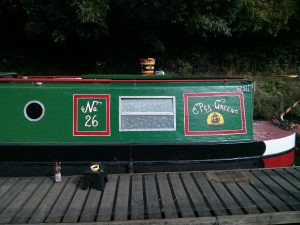
My boat is No 26 of the boats built by Chris Barney in Braunston. As well as those wanting to chat about Barney boats I have had a few people yell from other boats ‘what’s your number?’. As these males were invariably sharing the boat with a woman I guessed they didn’t mean my phone number, and the first couple of times I did yell my boat registration number. I thought these people were some sort of incognito CRT licence enforcers, though the fact they asked for the number didn’t really tally with the undercover nature of their work. It was only when someone yelled, ‘what number Barney have you got?’ I twigged what was going on. So, I decided to make life easier and add No 26 between the windows on the cabin. Of course, now I have to explain to non-Barney aficionados what the number means, which is fine, as it is sharing a little bit of canal history.
Job done
This final addition of the number and boxes didn’t happen until I was back in the marina. By that point I was feeling better about my painting. This was helped by the positive reaction of others in the marina to the name and picture and gave me confidence to continue. Admittedly, it was so much easier doing this on the still water of my mooring! And with that my boat, was all painted, renamed and sign-written, all within a year of having bought her on the mad day in 2016.
Wonderful!
Thank you 🙂
It is so great to read your blog and get knowledge about canal history. Here in Germany we have /had traditional River Boats,called Binnenschiffe.No really Comparison with Narrowboat Design but their History is.So its great to read about the History of the narrows.Thank you so much and Lovely Greetings Kerstin
Kerstin,
Thanks for reading and taking the time to comment. My only experience of the rivers in Germany is visiting the Rhine – the boats there seemed huge, especially compared to my little boat.
Kay